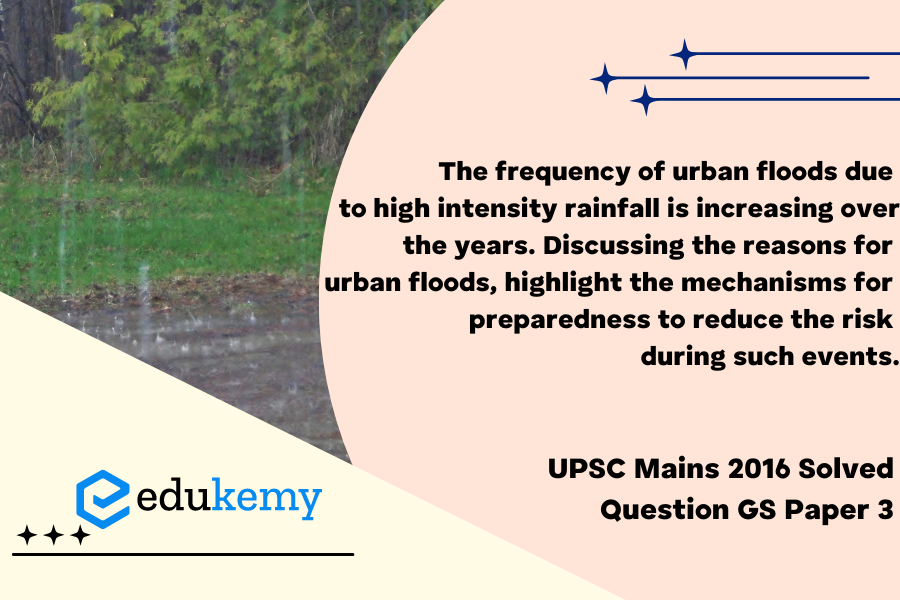In recent years, the frequency of urban floods has shown a notable surge, primarily attributed to the escalating intensity of rainfall events. This concerning trend underscores the urgent need to understand the root causes of urban floods and implement effective mechanisms for preparedness to mitigate the associated risks. Urbanization, climate change, inadequate drainage systems, and alterations in land use patterns are among the key factors contributing to the rising incidence of flooding in urban areas. As urban populations continue to grow, the expansion of impervious surfaces exacerbates runoff, overwhelming drainage infrastructure and leading to widespread inundation during intense rainfall episodes. Additionally, climate change-induced shifts in precipitation patterns contribute to the unpredictability and severity of rainfall, further intensifying the vulnerability of urban environments to flooding.
Tag: Disaster and disaster management.
Contents
Decoding the Question:
- In the Intro, try to start your answer by writing about Urban flooding.
- In Body,
- Discuss various reasons behind urban flooding
- Write various measures/ mechanism to reduce the risk of Urban floods.
- Try to conclude your answer as per context.
Answer:
Urban flooding is not just “flooding of urban areas”. It is significantly different from normal flooding/rural flooding. As urbanization leads to developed catchments it causes increased flood peaks from 1.8 to 8 times and flood volumes by up to 6 times. Urban areas are densely populated and people living in vulnerable areas suffer due to flooding, sometimes resulting in loss of life. It is not only the event of flooding but the secondary effect of exposure to infection also has its toll in terms of human suffering, loss of livelihood and, in extreme cases, loss of life. Recent water logging in Gurgaon, urban flood in Mumbai and Srinagar shows the increasing intensity of urban flood disasters in India.

Reasons behind urban flooding:
- A special feature in India is heavy rainfall during monsoons. There are other weather systems also that bring in a lot of rain. Storm surges can also affect coastal cities/ towns.
- The urban heat island effect has increased rainfall over urban areas. Global climate change is resulting in changed weather patterns and increased episodes of high-intensity rainfall events occurring in shorter periods.
- Stormwater drainage systems in the past were designed for rainfall intensity of 12–20 mm. These capacities get easily overwhelmed whenever rainfall of higher intensity is experienced. Further, the systems very often do not work to the designed capacities because of very poor maintenance.
- Encroachments are also a major problem in many cities and towns. The flow of water has increased in proportion to the urbanization of the watersheds. Ideally, the natural drains should have been widened (similar to road widening for increased traffic) to accommodate the higher flows of stormwater. But on the contrary, there have been large-scale encroachments on the natural drains and the river floodplains. Consequently, the capacity of the natural drains has decreased, resulting in flooding.
- Improper disposal of solid waste, including domestic, commercial, and industrial waste, and dumping of construction debris into the drains also contribute significantly to reducing drainage capacities.
- The presence of impervious cover near trees and on road pavements also reduces water runoff.
Measure to reduce the risk of urban flooding:
- Cleaning of drainage: Before monsoon, we need to clean the drainage system of every city and make sure the drainage system is not choked which can potentially create a barrier for running flood water.
- Complete ban of plastic: Banning plastic is required to keep all drainage systems choke-free. Without an intensive awareness drive and people’s cooperation, it cannot be achieved.
- Relook of all the storm’s water carriage systems: Need to identify old Storm’s water-carrying systems capable of carrying large amounts of water easily. Their maintenance and upgradation should be accorded priority.
- Smart urban planning: An early warning system and keeping all the authorities on standby mode is a much-needed step to respond in real-time situations. The use of drones, radars, and thematic maps for better understanding of trends and areas that affect frequently can help in better planning.
- Rainwater harvesting: It has twin benefits first it will help in combating urban floods and second help in increasing groundwater.
Due to climate change urban floods is becoming recurrent phenomena and coping with this problem is the need of the hour. With urban centers becoming significant for economic activities as well as for habitation of large populations-often in congested clusters, it is imperative to reduce the risk of urban flooding at the earliest.
In case you still have your doubts, contact us on 9811333901.
For UPSC Prelims Resources, Click here
For Daily Updates and Study Material:
Join our Telegram Channel – Edukemy for IAS
- 1. Learn through Videos – here
- 2. Be Exam Ready by Practicing Daily MCQs – here
- 3. Daily Newsletter – Get all your Current Affairs Covered – here
- 4. Mains Answer Writing Practice – here


